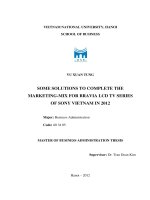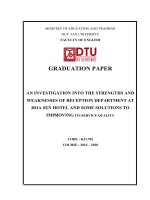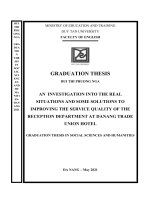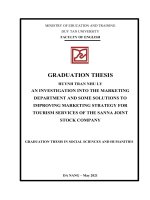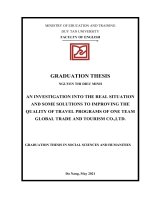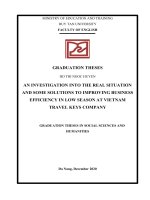Some solutions to improving the marketing mix strategy at tam thai agro forestry products processing joint stock company
Bạn đang xem bản rút gọn của tài liệu. Xem và tải ngay bản đầy đủ của tài liệu tại đây (423.91 KB, 64 trang )
DECLARATION
I hereby declare that this graduation thesis is my work with the support of my
supervisor and has not copied the work of others. The secondary information used in
the thesis is original and cited.
I take full responsibility for this pledge!
Student
Nguyễn Xuân Thúy
1
ABSTRACT
ACKNOWLEDMENTS
In the process of completing the thesis, I would like to thank the teachers and
lecturers of the Academy of Finance for equipping me with the most necessary
knowledge to be able to complete the thesis. In particular, I would like to express
my deep gratitude to Ms. Tran Thu Hoai for her enthusiastic guidance and
correction of errors so that I could successfully complete this graduation thesis.
I would like to express my sincere thanks to the Board of Directors of Tam
Thai Agro-Forestry Processing Joint Stock Company and the brothers and sisters in
the Marketing Department for creating conditions for me to practice and complete
the thesis.
This thesis cannot be error-free due to my internship at the firm and my
limited practical experience. As a result, I hope to receive the guidance of my
teachers to make my thesis more complete.
Thank you so much!
2
LIST OF ABBREVIATIONS
3
LIST OF FIGURES AND TABLES
List of figures
Figure 1.1: Channels for personal consumer products.............................................23
Figure 2.1: Logo of Tam Thai Agro-Forestry Products Processing Joint Stock
Company................................................................................................................. 27
Figure 2.2: Main products of Tam Thai Agro-Forestry Processing Joint Stock
Company................................................................................................................. 28
Figure 2.3: Stores provided by the company...........................................................29
Figure 2.4: Structure Organogram of Company Tam Thai......................................30
Figure 2.5: Survey results of customers' opinions on the quality of products from
Tam Thai Company.................................................................................................35
Figure 2.6: Survey results of customers about the diversity and richness of Tam
Thai Company's products........................................................................................36
Figure 2.7: Survey results of customers about the packaging of products from Tam
Thai company..........................................................................................................37
Figure 2.8: Survey results of customers about the price of products from Tam Thai
Company................................................................................................................. 38
Figure 2.9: Survey results of customers about the location of the headquarters of
Tam Thai Company.................................................................................................39
Figure 2.10: Survey results of customers about the convenience and ease of buying
directly from Tam Thai company............................................................................40
Figure 2.11: Survey results of customers who know the products of Tam Thai
Company................................................................................................................. 41
Figure 2.12: Survey results of customers about professional website design from
Tam Thai Company.................................................................................................42
4
Figure 2.13: Survey results of customers about a variety of promotions, suitable for
many customers from Tam Thai Company..............................................................43
Figure 2.14: Survey results of customers on public relations activities from Tam
Thai Company.........................................................................................................44
List of table
Chart 2.1: Business results of Tam Thai company in the period of 2019-2022.......33
5
TABLE OF CONTENTS
DECLARATION....................................................................................................... 1
ABSTRACT.............................................................................................................. 2
LIST OF ABBREVIATIONS...................................................................................3
LIST OF FIGURES AND TABLES.........................................................................4
TABLE OF CONTENTS..........................................................................................6
INTRODUCTION..................................................................................................... 8
1. RATIONALE OF THE STUDY.........................................................................8
DEVELOPMENT................................................................................................... 12
CHAPTER 1: LITERATURE REVIEW OF THE MARKETING MIX.................12
1.1 Marketing overview...........................................................................................12
1.1.1 Definition of Marketing..................................................................................12
1.1.2 Role of Marketing...........................................................................................13
1.1.3 Functions of Marketing..................................................................................13
1.1.4 Marketing Process..........................................................................................14
1.2 Overview of marketing mix...............................................................................15
1.2.1 Definition of Marketing Mix..........................................................................15
1.2.2 Role of Marketing Mix...................................................................................15
1.2.3 Elements in Marketing Mix............................................................................16
1.3 MARKETING-MIX STRATEGY CONTENT.................................................18
1.3.1 Product strategy..............................................................................................18
1.3.2 Price Strategy.................................................................................................21
1.3.3 Place strategy..................................................................................................23
1.3.4 Promotion strategy..........................................................................................24
6
CHAPTER 2: THE STUDY STATUS OF THE MARKETING MIX ACTIVITIES
AT TAM THAI AGRO-FORESTRY PRODUCTS PROCESSING JOINT STOCK
COMPANY............................................................................................................. 27
2.1 General overview of Tam Thai Agro-Forestry Products Processing Joint Stock
Company................................................................................................................. 27
2.1.1 Introduction....................................................................................................27
2.1.2 Business sectors..............................................................................................28
2.1.3 The process of formation and development....................................................28
2.1.4 Organizational structure..................................................................................30
2.2 Status of the marketing mix activities at Tam Thai Agro-Forestry Products
Processing Joint Stock Company.............................................................................33
2.2.1 Product strategy..............................................................................................33
2.2.2 Price strategy..................................................................................................37
2.2.3 Place strategy..................................................................................................38
2.2.4 Promotion strategy..........................................................................................40
2.3 General assessment of marketing mix activities at Tam Thai Agro-Forestry
Products Processing Joint Stock Company..............................................................45
2.3.1 Achievements.................................................................................................45
2.3.2 Limitations and existences..............................................................................46
2.3.3 Causes of limitations and existences...............................................................47
CHAPTER 3.PERFECT THE MARKETING MIX STRATEGY AT TAM THAI
AGRO-FORESTRY PRODUCTS PROCESSING JOINT STOCK COMPANY..50
3.1 Orientation of marketing mix activities of Tam Thai Company........................50
3.2 Measures to improve pricing strategy...............................................................50
3.2.1 Product solutions............................................................................................51
7
3.2.2 Price solutions................................................................................................54
3.2.3 Place solutions................................................................................................55
3.2.4 Promotion solutions........................................................................................57
3.2.5 Human resource development solutions.........................................................59
CONCLUSION....................................................................................................... 62
REFFRENCE.......................................................................................................... 63
8
INTRODUCTION
1. RATIONALE OF THE STUDY
Today, as the economy grows, many large and small businesses are
growing and asserting their market position. Each business must have appropriate
development strategies to develop and compete with other businesses. Marketing
strategies, particularly the marketing mix strategy, play an essential role in the
business process by assisting businesses in developing the most complete and
synchronized marketing system between the stages of product development, pricing,
promoting product advertising, and distribution to consumers and from there,
creating maximum satisfaction for customers, and helping businesses achieve profit
goals.
During my internship at Tam Thai Agro-Forestry Processing Joint Stock
Company, I discovered that the company is one of the most prestigious enterprises
in Hanoi, and that it has gradually overcome difficulties to maintain its market
position in the current volatile economic situation. Tam Thai Agro-Forestry
Processing Joint Stock Company has worked hard to develop and improve its
customer service. The company has applied the marketing mix to production and
business activities and has seen initial success; however, it has not yet fully realized
the marketing mix's potential, so the product consumption market remains relatively
small. In the coming time, in order to expand the market all over the country,
export, and improve its image and reputation, Tam Thai Agro-Forestry Processing
Joint Stock Company needs to invest and perfect more marketing mix activities.
Recognizing the above importance, I made the decision to select the topic
“Some solutions to improving the marketing mix strategy at Tam Thai Agro-
Forestry Products Processing Joint Stock Company” for a graduate thesis in my
university training program.
2. AIM OF THE STUDY
Analyze and evaluate the current situation of the company's marketing
mix activities in order to offer solutions to improve those activities in the future.
9
The specific goals are set out as follows:
First, clarify the general rationale for the marketing mix.
Second, analyze the company's marketing mix strategy for the period of 2020–
2022.
Third, propose solutions to improve marketing mix activities at Tam Thai
Agro-Forestry Processing Joint Stock Company.
3. METHODS OF THE STUDY
The research methods used in the thesis are combined to produce data that
reflect the research problem comprehensively, objectively, and multidimensionally,
such as data collection methods, analytical methods, compare and synthesize, and
the SWOT analysis method.
4. SCOPE OF THE STUDY
About time: Research data for the year 2020-2021-2022
About space: The topic was researched at Tam Thai Agro-Forestry Processing
Joint Stock Company.
About the content: The thesis focuses on researching the general theoretical
basis of the marketing mix, thereby analyzing the current situation of the company's
marketing mix activities and offering solutions for the future.
5. ORGANIZATION OF THE STUDY
The report includes 3 chapters:
Chapter 1: Literature review of the marketing mix
Chapter 2: The study status of the marketing mix activities at Tam Thai
Agro-Forestry Processing Joint Stock Company.
Chapter 3: Recommendations for some solutions to perfect the
Marketing-Mix strategy at Tam Thai Agro-Forestry Processing Joint Stock
Company
10
CHAPTER 1: LITERATURE REVIEW OF THE MARKETING MIX
1.1 Marketing overview
1.1.1 Definition of Marketing
1.1.2 Role of Marketing
1.1.3 Functions of Marketing
1.1.4 Marketing Process
1.2 Overview of marketing mix
1.2.1 Definition of Marketing Mix
1.2.2 Role of Marketing Mix
1.2.3 Elements in Marketing Mix
1.3 MARKETING-MIX STRATEGY CONTENT
1.3.1 Product strategy
1.3.1.1 Product mix
1.3.2 Price Strategy
1.3.3 Place strategy
1.3.4 Promotion strategy
Summary of chapter 1
CHAPTER 2: THE STUDY STATUS OF THE MARKETING MIX
ACTIVITIES AT TAM THAI AGRO-FORESTRY PROCESSING JOINT
STOCK COMPANY
The study status of the
2.1 General overview of Tam Thai Agro-Forestry Products Processing
Joint Stock Company
2.1.1 Introduction
2.1.2 Business sectors
2.1.3 The process of formation and development
2.1.4 Organizational structure
2.1.5 Revenue situation of Tam Thai company in the period of 2019-2022
11
2.2 Status of the marketing mix activities at Tam Thai Agro-Forestry
Products Processing Joint Stock Company
2.2.1 Product strategy
2.2.2 Price strategy
2.2.3 Place strategy
2.2.4 Promotion strategy
2.3 General assessment of marketing mix activities at Tam Thai Agro-
Forestry Products Processing Joint Stock Company
2.3.1 Achievements
2.3.2 Limitations and existences
2.3.3 Causes of limitations and existences
Summary of chapter 2
CHAPTER 3: RECOMMENDATIONS FOR SOME SOLUTIONS TO
PERFECT THE MARKETING MIX STRATEGY AT TAM THAI AGRO-
FORESTRY PROCESSING JOINT STOCK COMPANY
3.1 Orientation of marketing mix activities of Tam Thai Company
3.2 Measures to improve pricing strategy
3.2.1 Product solutions
3.2.2 Price solutions
3.2.3 Place solutions
3.2.4 Promotion solutions
3.2.5 Human resource development solutions
Summary of chapter 3
12
DEVELOPMENT
CHAPTER 1: LITERATURE REVIEW OF THE MARKETING MIX
1.1 Marketing overview
1.1.1 Definition of Marketing
Marketing slowly gains popularity and is used everywhere after a lengthy
period of emergence and growth. The earliest marketing efforts were carried out in
Japan in the 1650s, but by the early 19th century, marketing had begun to be studied
systematically in the West. Particularly in Vietnam, the research and application of
marketing in businesses have existed in the South since 1975, and in 1989, it was
taught at a number of universities and gradually became widely used to this day.
There are many definitions of marketing, but they mainly revolve around two
main perspectives: traditional marketing and modern marketing. Traditional
marketing's main idea is to sell what the business can produce and focus on
distributing those products. Typical for this view, according to John H. Crighton
(1960), "marketing" is the process of effective management of product, price, place,
and promotion to meet customer needs and achieve profits for the business.
Different from the classical marketing concept, modern marketing believes that the
customer is the first concern and needs to focus on satisfying the needs of the
customer. According to the American Marketing Association (2013), marketing is
the set of organizations that carry out business activities such as communication,
distribution, and exchange to create great value for the organization and its
stakeholders, such as customers, partners, and society. Similarly, Philip Kotler
(2016), the father of modern marketing, has defined "marketing as the process of
creating value for customers and building relationships with them to solve their
problems profitably. It requires understanding, creating, and communicating value
to customers and managing relationships with them in a sustainable way."
We may summarize marketing definitions as follows: "Marketing is the
process by which an individual or an organization can satisfy its wants and needs by
creating and exchanging products with others."
13
In general, marketing is viewed as the skill of identifying a need and
determining how to meet that need. To address this demand, thorough market
research, corporate climate, and customer behavior are required. Furthermore, the
marketing process requires a tight collaboration of divisions in the organization to
identify demands and devise a strategy to meet them, resulting in maximum profit
for the company.
1.1.2 Role of Marketing
Businesses are now beginning to realize the role of marketing in business, in
tandem with the process of economic growth. Marketing has become the new
business philosophy since its function has grown in importance. The following is a
general summary of marketing's role:
First, marketing guides businesses in the art of discovering customer
satisfaction, orienting marketing for business activities, and taking the initiative for
enterprises.
Second, marketing serves as a link to assist businesses in resolving
connections and aligning the interests of stakeholders such as firms, customers, and
society.
Third, marketing is a competitive tool that helps businesses find a place and
establish their reputation in the market. In the market mechanism, businesses freely
compete to be able to meet the needs of customers in the best way. Profits for
businesses can only be realized through meeting client wants, and then marketing
becomes a key factor determining the business results of enterprises.
After all, marketing has become the "center" of all company activity; other
business decisions such as technology, finance, and human resources are largely
dependent on marketing decisions such as: What products to produce? Which
market are you targeting? How is the production going? In what quantity?
1.1.3 Functions of Marketing
While manufacturing creates products, marketing creates customers and
markets.
14
First of all, marketing does market research and needs detection. This function
includes activities such as researching potential and predicting market prospects, as
well as gathering information about the market and competitors. In addition, there
are activities to analyze the behavior, tastes, and needs of customers, thereby clearly
identifying target customers.
Second, marketing aids in demand adaptation. Demand adaptation implies
addressing the market's demands in terms of products, pricing, consumption,
information, and marketing communication activities through market research and
consumer wants.
Third, marketing drives demand and satisfies ever-increasing needs.
Consumers' needs are increasingly diversified in the direction of socio-economic
development. Marketing emerges with product, pricing, distribution, and
communication studies that help satisfy consumer needs.
Besides, marketing also has the function of economic efficiency. Satisfying
needs is the way for businesses to have sales and profits that are effective and long-
term.
Finally, marketing is responsible for coordinating the operations of the
company's departments. Marketing must collaborate with other divisions in the
organization to achieve the company's common goals and please consumers.
1.1.4 Marketing Process
Marketing considers the customer as the center; the essence of marketing is to
satisfy the needs of customers to the maximum. To do this, the business's marketing
process must follow these five key steps:
R → STP → MM → I→ C
R (Research ): Research is a process that includes collecting, processing, and
analyzing marketing information, such as information about the consumer market,
the environment, etc. In addition, research activities also help businesses identify
15
consumer tastes, opportunities, and market risks and prepare appropriate conditions
and strategies to participate in the market.
STP (segmentation, targeting, positioning): It helps businesses discover many
customer segments. Businesses must identify which segments and target consumer
groups will give them exceptional value. Businesses must segment, analyze, and
select the best market for them in order to determine which market to target.
Businesses must also position their items so that customers can understand the
major benefits of the product and differentiate it from competitors in the market.
MM (Marketing Mix): From the selected market base, the business will design
a marketing mix strategy to orient and serve that target market.
I (Implementation): The process of putting marketing strategies and plans into
action. Businesses will arrange and implement the marketing strategy by developing
particular action programs and organizing human resources to implement them.
C (Control): Enterprises must collect feedback from the market, evaluate and
measure the results of marketing activities to determine whether they achieve the set
goals or not, and from there design corrective actions.
1.2 Overview of marketing mix
1.2.1 Definition of Marketing Mix
A marketing mix is a combination of controllable elements that a business
uses to influence target markets to achieve planned objectives.
The marketing-mix model was first introduced in the 1960 book "Basic
Marketing: A Managerial Approach" by Jerome McCarthy. Accordingly, the
marketing mix model consists of four basic elements: product, price, place, and
promotion. This model has become an important tool for marketers to develop their
marketing strategies and bring their products to customers effectively.
1.2.2 Role of Marketing Mix
For businesses: The marketing mix is the rope that connects the manufacturing
operations of firms or organizations in the market. It assists firms in researching and
developing new items, as well as pricing products that are competitive and stand out
16
in the market. That is not sufficient; the goods must also be distributed. Only after
the items have been distributed will the firm be able to recoup its initial investment.
In terms of communication, it is more than just a policy to support distribution,
pricing, and goods; it is also a communication bridge between customers and
enterprises to generate market advantages and distinctions.
For customers: The marketing mix sees a product that they require to meet a
demand and that the price is reasonable enough for customers to be ready to pay for
that product. Furthermore, the product is always available when needed. The
marketing mix has established favorable conditions for supply and demand to meet
through two-way information, i.e., from business to user and vice versa.
For society: Marketing is today recognized not just as a business but also as an
essential duty in society. Making a difference in people's lives and raising the level
of life in society.
1.2.3 Elements in Marketing Mix
As introduced, the marketing mix is also known as the 4 Ps, with four
components: product, price, place, and promotion. Each product, price, place, or
promotion strategy has a certain role and impact. In order to maximize the
effectiveness of marketing activities, it is necessary to have smooth coordination
and scientific organization in consideration of each other to satisfy the marketing
objectives of the business.
1.2.3.1 Product
A product is something that a business offers, associated with satisfying the
needs and wants of customers in order to attract attention, purchase, or use them.
Besides, the products of each business often have differences in physical or
psychological factors, so depending on the characteristics of the industry, they focus
on these factors in different ways.
Product strategy is the orientation and decision-making related to the
production and sale of products to ensure the satisfaction of customers' needs in
each period of business activities and marketing objectives of the enterprise.
17
1.2.3.2 Price
Price is the amount of money a customer has to pay a seller to use a product or
service. From the seller's perspective, the price of a product is the revenue that the
seller gets from selling that product. Price is also the relationship between the
exchange of goods in the market; an exchange through price is an exchange based
on the value of the products and services exchanged.
Pricing strategies are long-term price orientations aimed at achieving a
business's business goals. It is expressed on two levels: the goal and the means. This
means that the pricing strategy must be aimed at achieving the business goals of the
business and must be implemented through means to achieve the set goals.
1.2.3.3 Place
The place is a system of activities aimed at delivering a product, service, or
solution to the consumer at a given time and to a certain place to satisfy the
expected needs of the intermediaries or the end consumer.
A place channel is a set of interdependent independent businesses or
individuals engaged in the process of bringing a product, service, or solution to the
consumer at a given time in a certain place and achieving the company's goals in the
market.
Place strategy is a set of principles through which businesses can achieve their
distribution goals. The principles include decisions regarding the establishment of
distribution channels, the selection of solutions, the establishment of relationships in
distribution channels and networks, and issues related to physical distribution.
1.2.3.4 Promotion
Promotion is an activity to provide information about products, services, or
brands to convince consumers about product features, build corporate image, create
awareness, build confidence, and promote consumption through consumption
promotion programs.
A promotion strategy is a collection of activities involving information, the
introduction of products, brands, and organizations, and measures to stimulate
18
consumption in order to achieve the communication goals of the business. It is also
the coordination of communication tools to achieve the communication objectives.
There are five main marketing communication tools, including advertising,
promotion, public relations, direct selling, and direct marketing.
1.3 MARKETING-MIX STRATEGY CONTENT
1.3.1 Product strategy
1.3.1.1 Product mix
The product mix is the collection of all product categories that a business
produces. It includes measurements:
Width: The number of products or services the business intends to offer to the
market. It is considered a business product portfolio, showing the level of product
diversification of the enterprise.
Length: each type of business product will have many different categories; the
number of categories determines the length of the product portfolio, which
businesses often call the product line.
Depth: Product design associated with each product category
Enterprises can make business product portfolio decisions based on an
analysis of the market condition and its capabilities, such as limiting the business
product portfolio, expanding products, or changing business products. Regarding
product lines, businesses can narrow their product lines when they realize that some
product categories do not satisfy customer needs and do not bring profits to the
business. Contrary to product line expansion to increase the ability to choose
products and satisfy the needs of different customer groups, modernize product
lines to eliminate obsolete product categories, improve them, and introduce newer
products.
1.3.1.2 Product trademark
A trademark is a name, term, sign, symbol, design, or combination thereof
intended to identify the goods or services of an undertaking and differentiate them
19
from those of competitors. A product trademark must comprise the following
components:
Brand name: A trademark's readable portion.
Symbol: The representation of an identifiable brand using stylized imagery,
specific colors, or brand names designed in a particular style.
In addition to identifying or differentiating the product from other competing
items, trademarks represent the product's attributes and benefits, the business's
committed attitude, and the user's personality.
As a result, businesses attempting to establish a trademark reputation are
frequently interested in marketing elements linked to products, such as high-quality
items that meet the wants and tastes of their customers.
1.3.1.3 Decisions related to product characteristics
Product quality
Product quality is defined as the sum of a product's prices and qualities that
demonstrate fulfillment of demands under defined consumption settings in line with
the product's use.
Businesses can choose to trade items of low, medium, or high quality when
adopting a brand based on the brand positioning criteria they have selected when
targeting the target market. Some organizations focus on a single quality level for
all of their products; however, most firms aim for multiple quality levels to meet the
demands of various consumer groups. The company has a highly tight quality
management system to assure product quality throughout the production and
business processes, as well as consumer confidence in the product's quality and
reputation.
Over time, the quality management strategy is implemented in the following
directions: Firstly, businesses will focus on investing in research to regularly
improve quality. Second, maintain product quality and ensure product quality does
not change. Third, degrade product quality to compensate for increasing
manufacturing costs or boost profit margins.
20

